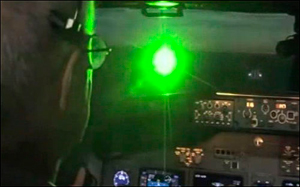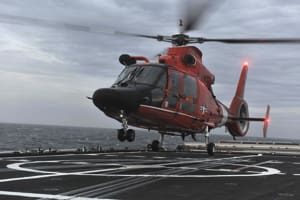A MH-65C Dolphin helicopter crew flying out of U.S. Coast Guard Air Facility Muskegon, Mich., on Aug. 17 was endangered when a green laser was directed toward them from the shore during routine training operations.
At about 2200, the coxswain of a Coast Guard small boat again spotted the laser illuminating the helicopter, this time appearing to track the helicopter as it moved. The source of the laser was traced back to a group of individuals who were observed around a campfire flashing a pattern of light signals with a red light. When the Coast Guard small boat crew approached the shoreline and illuminated the group with a spotlight, all of the individuals scattered and fled the area.
Following the incident the Coast Guard announced a $1,000 reward for information leading to the identification, arrest and conviction of the individual or individuals responsible for the illumination by green laser of the helicopter.
 |
|
FAA |
|
When pointed at aircraft, laser pointers can temporarily blind pilots. The farther the beam travels, the wider it becomes and can have the effect of a flash bulb going off in the cockpit. |
This was not an isolated incident in the area. On another occasion a Coast Guard helicopter was illuminated by lasers that originated in Canada. Also, in 2007, a Massachusetts man was sentenced to three years in federal prison, for the Dec. 8, 2007, illumination of a state police helicopter. The charges included “willfully interfering with an aircraft operator with reckless disregard for human life,” and making false statements to arresting officers.
In another incident, a helicopter that was escorting a liquefied natural gas tanker through Boston Harbor was illuminated by 52-year-old Gerard Sasso, who aimed a Class 3B green laser, said to be “at least five to 10 times more powerful than an ordinary laser pointer” (approximately 25 to 50 milliwatts). The pilots took evasive action, but the cockpit was hit and filled with “an intense sparkling green light.” The pilots and Coast Guard were able to trace the source to Sasso’s apartment in Medford, Mass.
News reports quoted prosecutors as saying that Sasso was the second person in the U.S. to be convicted of lasing an aircraft. They also pointed to the November 2009 sentence of a California man who received two-and-a-half years for shining a laser at two airplanes and temporarily blinding a pilot.
Commercial aircraft have also been subjected to these laser attacks. In July 2012, a JetBlue pilot approaching JFK was hit with a laser and suffered minor eye injury. The plane landed safely.
Green lasers present a significant risk to flight safety, especially for helicopters at low altitudes and aircraft taking off or landing and for boat crews operating at night. If any aircrew member’s vision is compromised during a flight, Coast Guard flight rules dictate that the aircrew must abort its mission. A delay during a search and rescue operation could result in the death of the people the Coast Guard is attempting to rescue.
The Coast Guard encourages members of the public who witness someone committing this crime to immediately call 911 to report the incident.
The Federal Aviation Administration reports laser incidents rose 902 percent from 2005 to 2011. Shining any laser at an aircraft is a federal offense under 14 CFR 19.11. Several people have been convicted under this Federal law as well as similar state laws. These convictions have resulted in prison terms as long as five years and fines of up to $11,000, and five years probation.

